Techno–Econo–Enviro Energy Analysis, Ranking and Optimization of Various Building-Integrated Photovoltaic (BIPV) Types in Different Climatic Regions of Iran
Abstract
1. Introduction
1.1. The Importantce of Using BIPVs
1.2. The Latest Status of BIPVs
1.3. Types of BIPVs
1.4. Literature Review
1.5. Contribution of Present Work
2. Studied Cities
3. Software Used
4. Methodology
4.1. HOMER Software
4.2. SWARA Method
- First step: the indices are placed in accordance with their importance from the most significant to least significant;
- Second Step: relative significance of each index () is determined.
- Third step: the coefficient, which is a function that measures the relative significance of each index [45].
- Fourth step: the initial weight of each index is calculated through equation 13. The weight of the most significant index is considered to be equal to 1 [45].
- Fifth Step: the final normal weight is calculated through equation 14 [45].
4.3. EDAS Technique
4.4. ARAS Technique
4.5. WASPAS Technique
4.6. TOPSIS Technique
5. Input Data
6. Results
6.1. HOMER Simulation
6.2. Data Analysis
6.2.1. Criteria Weighting Using SWARA Method
6.2.2. Ranking Cities of Iran Using MCDM Methods
7. Conclusions
- -
- 30° and 90° angles were the most suitable and unsuitable angles in terms of economic and solar power generation, respectively.
- -
- The lowest cost per kWh of solar power generated is USD 0.073 (30° angle and Jask city).
- -
- The highest percentage of electricity supply by solar cells is 88.8% (30° angle and Jask city).
- -
- Weighting the parameters of the problem was done using the SWARA method and then the ranking was done using methods EDAS, ARAS, WASPAS, and TOPSIS.
- -
- The results of different ranking methods EDAS, ARAS, and WASPAS were similar, and only the results of the TOPSIS method were different for the cities of Dezful and Jask.
- -
- With normalized weight of 0.159, the “payback time” parameter had the highest weight among the studied parameters. The lowest weight with the amount of 0.045 is related to “inverter losses”.
- -
- In the final ranking of cities, Jask is the most suitable and Ramsar is the most unsuitable.
- -
- For an angle of 30° at Jask city, 39 MWh of solar electricity is generated annually, which prevents the annual emission of 16.5 tons of CO2 pollutants.
- -
- The lowest return time with 11.7 years is related to Jask city (30° angle), and the highest return time with more than 25 years is related to Ramsar city (90° angle).
Author Contributions
Funding
Data Availability Statement
Conflicts of Interest
References
- Martín-Chivelet, N.; Kapsis, K.; Wilson, H.R.; Delisle, V.; Yang, R.; Olivier, L.; Polo, J.; Eisenlohr, J.; Roy, B.; Maturi, L.; et al. Building-Integrated Photovoltaic (BIPV) products and systems: A review of energy-related behavior. Energy Build. 2022, 262, 111998. [Google Scholar] [CrossRef]
- Skandalos, N.; Wang, M.; Kapsalis, V.; D’Agostino, D.; Parker, D.; Bhuvad, S.S.; Peng, J.; Karamanis, D. Building PV integration according to regional climate conditions: BIPV regional adaptability extending Köppen-Geiger climate classification against urban and climate-related temperature increases. Renew. Sustain. Energy Rev. 2022, 169, 112950. [Google Scholar] [CrossRef]
- IRENA. Renewable Capacity Statistics 2020; International Renewable Energy Agency: Abu Dhabi, UAE, 2020; Available online: https://irena.org/publications/2020/Mar/Renewable-Capacity-Statistics-2020 (accessed on 20 June 2021).
- Mints, P. The Solar Flare–SPV Market Research. 2019. Available online: https://www.spvmarketresearch.com (accessed on 20 June 2021).
- Sorgato, M.J.; Schneider, K.; Rüther, R. Technical and economic evaluation of thin-film CdTe building-integrated photovoltaics (BIPV) replacing façade and rooftop materials in office buildings in a warm and sunny climate. Renew. Energ. 2018, 118, 84–98. [Google Scholar] [CrossRef]
- Shukla, A.K.; Sudhakar, K.; Baredar, P. Recent advancement in BIPV product technologies: A review. Energy Build. 2017, 140, 188–195. [Google Scholar] [CrossRef]
- Krawietz, A.; Silke, A. Sustainable buildings and BIPV: An international perspective. SETA Network. 2011. Available online: https://www.bre.co.uk/filelibrary/BIPV%202/Silke_Krawietz.pdf (accessed on 20 June 2021).
- Saretta, E.; Caputo, P.; Frontini, F. A review study about energy renovation of building facades with BIPV in urban environment. Sustain. Cities Soc. 2019, 44, 343–355. [Google Scholar] [CrossRef]
- Kuhn, T.E.; Erban, C.; Heinrich, M.; Eisenlohr, J.; Ensslen, F.; Neuhaus, D.H. Review of Technological Design Options for Building Integrated Photovoltaics (BIPV). Energy Build. 2020, 23, 110381. [Google Scholar] [CrossRef]
- Gonçalves, J.E.; van Hooff, T.; Saelens, D. Understanding the behaviour of naturally-ventilated BIPV modules: A sensitivity analysis. Renew. Energ. 2020, 161, 133–148. [Google Scholar] [CrossRef]
- Goncalves, J.E.; van Hooff, T.; Saelens, D. A physics-based high-resolution BIPV model for building performance simulations. Sol. Energy 2020, 204, 585–599. [Google Scholar] [CrossRef]
- Gholami, H.; Røstvik, H.N.; Müller-Eie, D. Holistic economic analysis of building integrated photovoltaics (BIPV) system: Case studies evaluation. Energy Build. 2019, 203, 109461. [Google Scholar] [CrossRef]
- ReportLinker. Global Building Integrated Photovoltaics (BiPV) Industry. 2021. Available online: https://www.reportlinker.com/p03037269/Global-Building-Integrated-Photovoltaics-BIPV-Industry.html?utm_source=GNW (accessed on 20 June 2021).
- Ballif, C.; Perret-Aebi, L.E.; Lufkin, S.; Rey, E. Integrated thinking for photovoltaics in buildings. Nat. Energy 2018, 3, 438–442. [Google Scholar] [CrossRef]
- Biyik, E.; Araz, M.; Hepbasli, A.; Shahrestani, M.; Yao, R.; Shao, L.; Essah, E.; Oliveira, A.C.; Del Cano, T.; Rico, E.; et al. A key review of building integrated photovoltaic (BIPV) systems. Eng. Sci. Technol. Int. J. 2017, 20, 833–858. [Google Scholar] [CrossRef]
- Mordor Intelligence. Building Integrated Photovoltaic (BIPV) Market–Growth, Trends, COVID-19 Impact, and Forecasts (2021–2026). 2020. Available online: https://www.mordorintelligence.com/industry-reports/building-integrated-photovoltaic-market (accessed on 20 June 2021).
- Posnansky, M.; Szacsvay, T.; Eckmanns, A.; Jürgens, J. New electricity construction materials for roofs and façades. Renew. Energy 1998, 15, 541–544. [Google Scholar] [CrossRef]
- Benemann, J.; Chehab, O.; Schaar-Gabriel, E. Building-integrated PV modules. Sol. Energy Mater. Sol. Cells 2001, 67, 345–354. [Google Scholar] [CrossRef]
- Fraile, D.; Despotou, E.; Latour, M.; Slusaz, T.; Weiss, I.; Caneva, S.; Helm, P.; Goodal, J.; Fintikakis, N.; Schellekens, E. PV Diffusion in the Building Sector, European Photovoltaic Industry Association, Sunrise Project. 2008. Available online: https://www.eupvsec-proceedings.com/proceedings?paper=2654 (accessed on 20 June 2021).
- Shukla, A.K.; Sudhakar, K.; Baredar, P. Exergetic assessment of BIPV module using parametric and photonic energy methods: A review. Energy Build. 2016, 119, 62–73. [Google Scholar] [CrossRef]
- Shukla, A.K.; Sudhakar, K.; Baredar, P. A comprehensive review on design of building integrated photovoltaic system. Energy Build. 2016, 128, 99–110. [Google Scholar] [CrossRef]
- Roy, A.; Ghosh, A.; Bhandari, S.; Sundaram, S.; Mallick, T.K. Perovskite solar cells for BIPV application: A review. Buildings 2020, 10, 129. [Google Scholar] [CrossRef]
- Aste, N.; Del Pero, C.; Leonforte, F. The first Italian BIPV project: Case study and long-term performance analysis. Sol. Energy 2016, 134, 340–352. [Google Scholar] [CrossRef]
- Gholami, H.; Røstvik, H.N.; Kumar, N.M.; Chopra, S.S. Lifecycle cost analysis (LCCA) of tailor-made building integrated photovoltaics (BIPV) façade: Solsmaragden case study in Norway. Sol. Energy 2020, 211, 488–502. [Google Scholar] [CrossRef]
- Gholami, H.; Røstvik, H.N. Economic analysis of BIPV systems as a building envelope material for building skins in Europe. Energy 2020, 204, 117931. [Google Scholar] [CrossRef]
- Fazelpour, F.; Ziasistani, N.; Nazari, P.; Nazari, P.; Ziasistani, N. Techno-Economic Assessment of BIPV Systems in Three Cities of Iran. Multidiscip. Digit. Publ. Inst. Proc. 2018, 2, 1474. [Google Scholar]
- Quintana, S.; Huang, P.; Saini, P.; Zhang, X. A preliminary techno-economic study of a building integrated photovoltaic (BIPV) system for a residential building cluster in Sweden by the integrated toolkit of BIM and PVSITES. Intell. Build. Int. 2021, 13, 51–69. [Google Scholar] [CrossRef]
- Kumar, N.M.; Sudhakar, K.; Samykano, M. Performance evaluation of CdTe BIPV roof and façades in tropical weather conditions. Energy Sources A Recovery Util. Environ. Eff. 2020, 42, 1057–1071. [Google Scholar] [CrossRef]
- Mazzeo, D.; Matera, N.; De Luca, P.; Baglivo, C.; Congedo, P.M.; Oliveti, G. A literature review and statistical analysis of photovoltaic-wind hybrid renewable system research by considering the most relevant 550 articles: An upgradable matrix literature database. J. Clean. Prod. 2021, 295, 126070. [Google Scholar] [CrossRef]
- Alturki, A.A. Optimal design for a hybrid microgrid-hydrogen storage facility in Saudi Arabia. Energy Sustain. Soc. 2020, 12, 1–17. [Google Scholar] [CrossRef]
- Elmorshedy, M.F.; Elkadeem, M.R.; Kotb, K.M.; Taha, I.B.; El-Nemr, M.K.; Kandeal, A.W.; Sharshir, S.W.; Almakhles, D.J.; Imam, S.M. Feasibility study and performance analysis of microgrid with 100% hybrid renewables for a real gricultural irrigation application. Sustain. Energy Technol. Assess. 2022, 53, 102746. [Google Scholar] [CrossRef]
- Wei, Y.; Han, T.; Wang, S.; Qin, Y.; Lu, L.; Han, X.; Ouyang, M. An efficient data-driven optimal sizing framework for photovoltaics-battery-based electric vehicle charging microgrid. J. Energy Storage 2022, 55, 105670. [Google Scholar] [CrossRef]
- Ariae, A.R.; Jahangiri, M.; Fakhr, M.H.; Shamsabadi, A.A. Simulation of Biogas Utilization Effect on the Economic Efficiency and Greenhouse Gas Emission: A Case Study in Isfahan, Iran. Int. J. Renew. Energy Dev. 2019, 8, 149–160. [Google Scholar] [CrossRef]
- Dehkordi, M.H.R.; Isfahani, A.H.M.; Rasti, E.; Nosouhi, R.; Akbari, M.; Jahangiri, M. Energy-Economic-Environmental assessment of solar-wind-biomass systems for finding the best areas in Iran: A case study using GIS maps. Sustain. Energy Technol. Assess. 2022, 53, 102652. [Google Scholar] [CrossRef]
- Jahangiri, M.; Khalili Geshnigani, M.; Beigi Kheradmand, A.; Riahi, R. Meeting the Hospital Oxygen Demand with a Decentralized Autonomous PV System: Effect of PV Tracking Systems. Iran. J. Sci. Technol. Trans. Electr. Eng. 2022, 47, 1–15. [Google Scholar] [CrossRef]
- Mostafaeipour, A.; Jahangiri, M.; Saghaei, H.; Raiesi Goojani, A.; Chowdhury, M.; Techato, K. Impact of Different Solar Trackers on Hydrogen Production: A Case Study in Iran. Int. J. Photoenergy 2022, 2022, 3186287. [Google Scholar] [CrossRef]
- Rezaei, M.; Khalilpour, K.R.; Jahangiri, M. Multi-criteria location identification for wind/solar based hydrogen generation: The case of capital cities of a developing country. Int. J. Hydrog. Energy 2020, 45, 33151–33168. [Google Scholar] [CrossRef]
- Jahangiri, M.; Raeiszadeh, F.; Alayi, R.; Najafi, A.; Tahmasebi, A. Development of Rural Tourism in Iran Using PV-Based System: Finding the Best Economic Configuration. J. Renew. Energy Environ. 2022, 1–9. [Google Scholar]
- Ampah, J.D.; Afrane, S.; Agyekum, E.B.; Adun, H.; Yusuf, A.A.; Bamisile, O. Electric vehicles development in Sub-Saharan Africa: Performance assessment of a standalone renewable energy systems for hydrogen refuelling and electricity charging stations (HRECS). J. Clean. Prod. 2022, 376, 134238. [Google Scholar] [CrossRef]
- Agyekum, E.B.; Ampah, J.D.; Afrane, S.; Adebayo, T.S.; Agbozo, E. A 3E, hydrogen production, irrigation, and employment potential assessment of a hybrid energy system for tropical weather conditions–Combination of HOMER software, shannon entropy, and TOPSIS. Int. J. Hydrog. Energy 2022, 47, 31073–31097. [Google Scholar] [CrossRef]
- Al Garni, H.Z.; Mas’ud, A.A.; Baseer, M.A.; Ramli, M.A. Techno-economic optimization and sensitivity analysis of a PV/Wind/diesel/battery system in Saudi Arabia using a combined dispatch strategy. Sustain. Energy Technol. Assess. 2022, 53, 102730. [Google Scholar] [CrossRef]
- Ampah, J.D.; Jin, C.; Agyekum, E.B.; Afrane, S.; Geng, Z.; Adun, H.; Yusuf, A.A.; Liu, H.; Bamisile, O. Performance analysis and socio-enviro-economic feasibility study of a new hybrid energy system-based decarbonization approach for coal mine sites. Sci. Total Environ. 2022, 854, 158820. [Google Scholar] [CrossRef]
- Dehghan, H.; Pourfayaz, F.; Shahsavari, A. Multicriteria decision and Geographic Information System-based locational analysis and techno-economic assessment of a hybrid energy system. Renew. Energy 2022, 198, 189–199. [Google Scholar] [CrossRef]
- Mostafaeipour, A.; Rezaei, M.; Jahangiri, M.; Qolipour, M. Feasibility analysis of a new tree-shaped wind turbine for urban application: A case study. Energy Environ. 2020, 31, 1230–1256. [Google Scholar] [CrossRef]
- Keršuliene, V.; Zavadskas, E.K.; Turskis, Z. Selection of rational dispute resolution method by applying new step-wise weight assessment ratio analysis (SWARA). J. Bus. Econ. Manag. 2010, 11, 243–258. [Google Scholar] [CrossRef]
- Mostafaeipour, A.; Dehshiri, S.J.H.; Dehshiri, S.S.H.; Jahangiri, M. Prioritization of potential locations for harnessing wind energy to produce hydrogen in Afghanistan. Int. J. Hydrog. Energy 2020, 45, 33169–33184. [Google Scholar] [CrossRef]
- Mostafaeipour, A.; Jahangiri, M.; Haghani, A.; Dehshiri, S.J.H.; Dehshiri, S.S.H.; Sedaghat, A.; Saghaei, H.; Akinlabi, E.T.; Sichilalu, S.M.; Chowdhury, M.S.; et al. Statistical evaluation of using the new generation of wind turbines in South Africa. Energy Rep. 2020, 6, 2816–2827. [Google Scholar] [CrossRef]
- Mostafaeipour, A.; Dehshiri, S.J.H.; Dehshiri, S.S.H. Ranking locations for producing hydrogen using geothermal energy in Afghanistan. Int. J. Hydrog. Energy 2020, 45, 15924–15940. [Google Scholar] [CrossRef]
- Dahooie, J.H.; Dehshiri, S.J.H.; Banaitis, A.; Binkytė-Vėlienė, A. Identifying and prioritizing cost reduction solutions in the supply chain by integrating value engineering and gray multi-criteria decision-making. Technol. Econ. Dev. Econ. 2020, 26, 1311–1338. [Google Scholar] [CrossRef]
- Mostafaeipour, A.; Hosseini Dehshiri, S.J.; Hosseini Dehshiri, S.S.; Jahangiri, M.; Techato, K. A thorough analysis of potential geothermal project locations in Afghanistan. Sustainability 2020, 12, 8397. [Google Scholar] [CrossRef]
- Keshavarz Ghorabaee, M.; Zavadskas, E.K.; Olfat, L.; Turskis, Z. Multi-criteria inventory classification using a new method of evaluation based on distance from average solution (EDAS). Informatica 2015, 26, 435–451. [Google Scholar] [CrossRef]
- Zavadskas, E.K.; Turskis, Z. A new additive ratio assessment (ARAS) method in multicriteria decision making. Technol. Econ. Dev. Econ. 2010, 16, 159–172. [Google Scholar] [CrossRef]
- Zavadskas, E.K.; Turskis, Z.; Antucheviciene, J.; Zakarevicius, A. Optimization of weighted aggregated sum product assessment. Elektron. Ir Elektrotech. 2012, 122, 3–6. [Google Scholar] [CrossRef]
- Hwang, C.L.; Yoon, K. Methods for multiple attribute decision making. In Multiple Attribute Decision Making; Springer: Berlin/Heidelberg, Germany, 1981; pp. 58–191. [Google Scholar]
- Sharma, R.; Murthy, S.S.; Dutta, P.; Rao, B.S. Performance of solid state hydrogen storage assisted standalone polygeneration microgrids for various climatic zones of India. Energy 2022, 258, 124869. [Google Scholar] [CrossRef]
- Miah, M.A.; Rakib, N.; Habib, M.A.; Hasanuzzaman, M.; Saha, S. Techno-economic analysis and environmental impact assessment of 3 MW photovoltaic power plant in Bangladesh: A case study based on real data. Environ. Dev. Sustain. 2022, 141, 1–19. [Google Scholar] [CrossRef]
- Kuetche, C.F.M.; Tsuanyo, D.; Fopah-Lele, A. Analysis of Hybrid Energy Systems for Telecommunications Equipment: A Case Study in Buea Cameroon. Proc. E3S Web Conf. EDP Sci. 2022, 354, 02007. [Google Scholar] [CrossRef]
- Shabestari, S.T.; Kasaeian, A.; Rad, M.A.V.; Fard, H.F.; Yan, W.M.; Pourfayaz, F. Techno-financial evaluation of a hybrid renewable solution for supplying the predicted power outages by machine learning methods in rural areas. Renew. Energy 2022, 194, 1303–1325. [Google Scholar] [CrossRef]
- Mostafaeipour, A.; Qolipour, M.; Rezaei, M.; Jahangiri, M.; Goli, A.; Sedaghat, A. A novel integrated approach for ranking solar energy location planning: A case study. J. Eng. Des. Technol. 2020, 19, 698–720. [Google Scholar]
- Mostafaeipour, A.; Sedaghat, A.; Hedayatpour, M.; Jahangiri, M. Location planning for production of bioethanol fuel from agricultural residues in the south of Caspian Sea. Environ. Dev. 2020, 33, 100500. [Google Scholar] [CrossRef]
- Riayatsyah, T.M.I.; Geumpana, T.A.; Fattah, I.M.; Mahlia, T.M. Techno-Economic Analysis of Hybrid Diesel Generators and Renewable Energy for a Remote Island in the Indian Ocean Using HOMER Pro. Sustainability 2022, 14, 9846. [Google Scholar] [CrossRef]
- Kamal, M.M.; Asharaf, I.; Fernandez, E. Optimal renewable integrated rural energy planning for sustainable energy development. Sustain. Energy Technol. Assess. 2022, 53, 102581. [Google Scholar]
- Zaniani, J.R.; Dehkordi, R.H.; Bibak, A.; Bayat, P.; Jahangiri, M. Examining the possibility of using solar energy to provide warm water using RETScreen4 software (Case study: Nasr primary school of pirbalut). Curr. World Environ. 2015, 10, 835. [Google Scholar] [CrossRef]
- Akhavan Shams, S.; Ahmadi, R. Dynamic optimization of solar-wind hybrid system connected to electrical battery or hydrogen as an energy storage system. Int. J. Energy Res. 2021, 45, 10630–10654. [Google Scholar] [CrossRef]
- Rezk, H.; Alghassab, M.; Ziedan, H.A. An optimal sizing of stand-alone hybrid PV-fuel cell-battery to desalinate seawater at saudi NEOM city. Processes 2020, 8, 382. [Google Scholar] [CrossRef]
- Jahangiri, M.; Haghani, A.; Heidarian, S.; Mostafaeipour, A.; Raiesi, H.A.; Shamsabadi, A.A. Sensitivity analysis of using solar cells in regional electricity power supply of off-grid power systems in Iran. J. Eng. Des. Technol. 2020, 18, 1849–1866. [Google Scholar] [CrossRef]
- Ibrahim, M.M.; Mostafa, N.H.; Osman, A.H.; Hesham, A. Performance analysis of a stand-alone hybrid energy system for desalination unit in Egypt. Energy Convers. Manag. 2020, 215, 112941. [Google Scholar] [CrossRef]

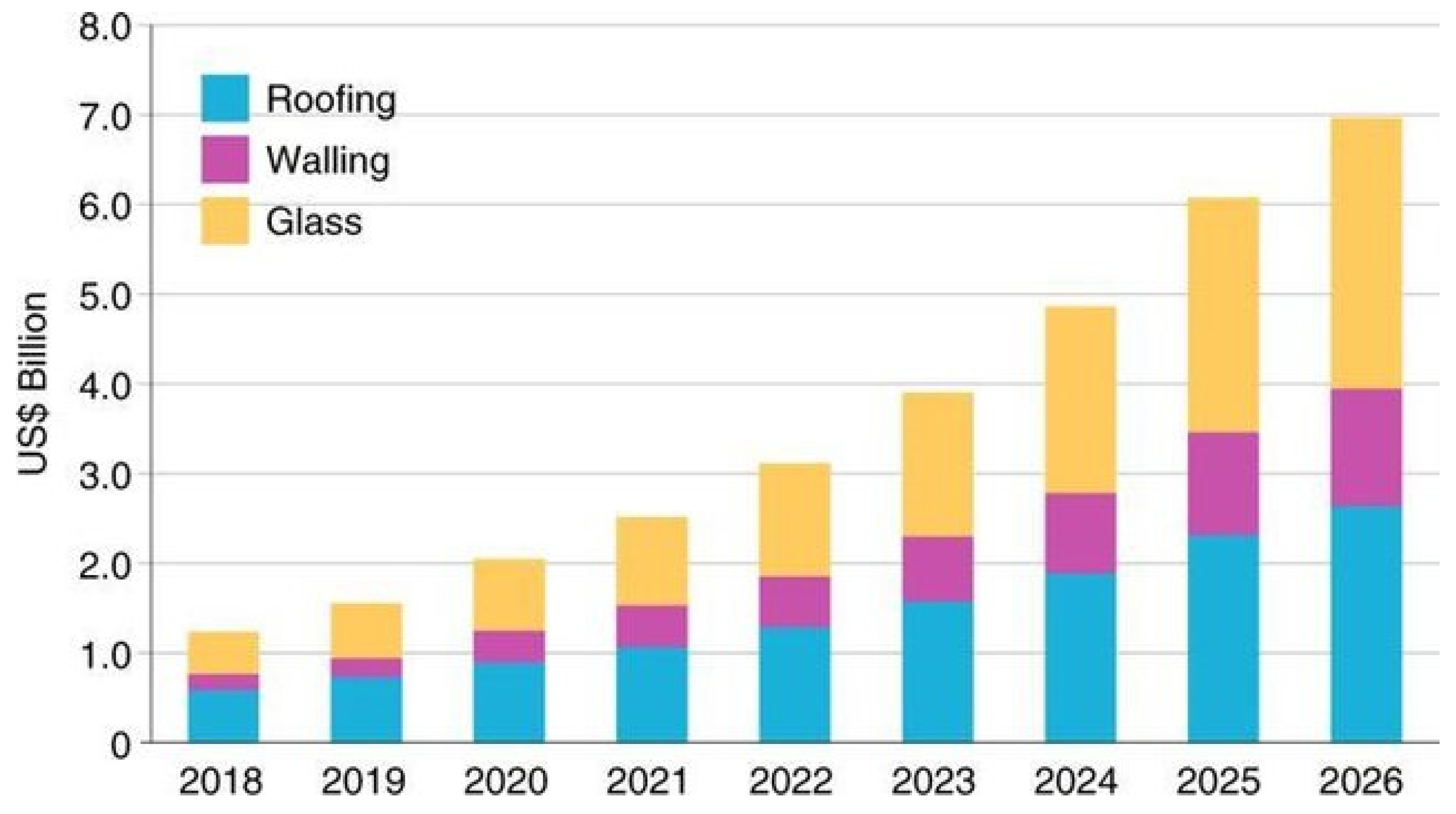
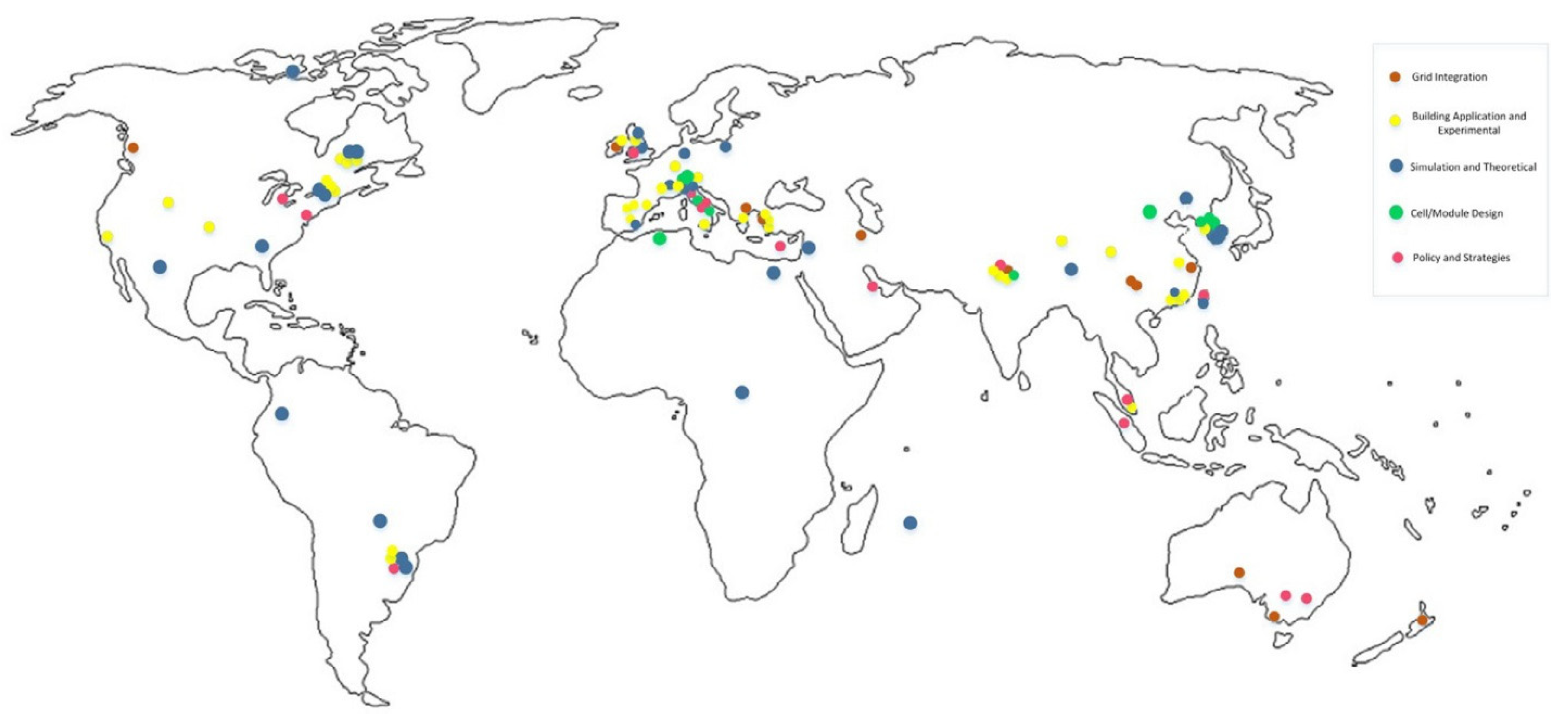
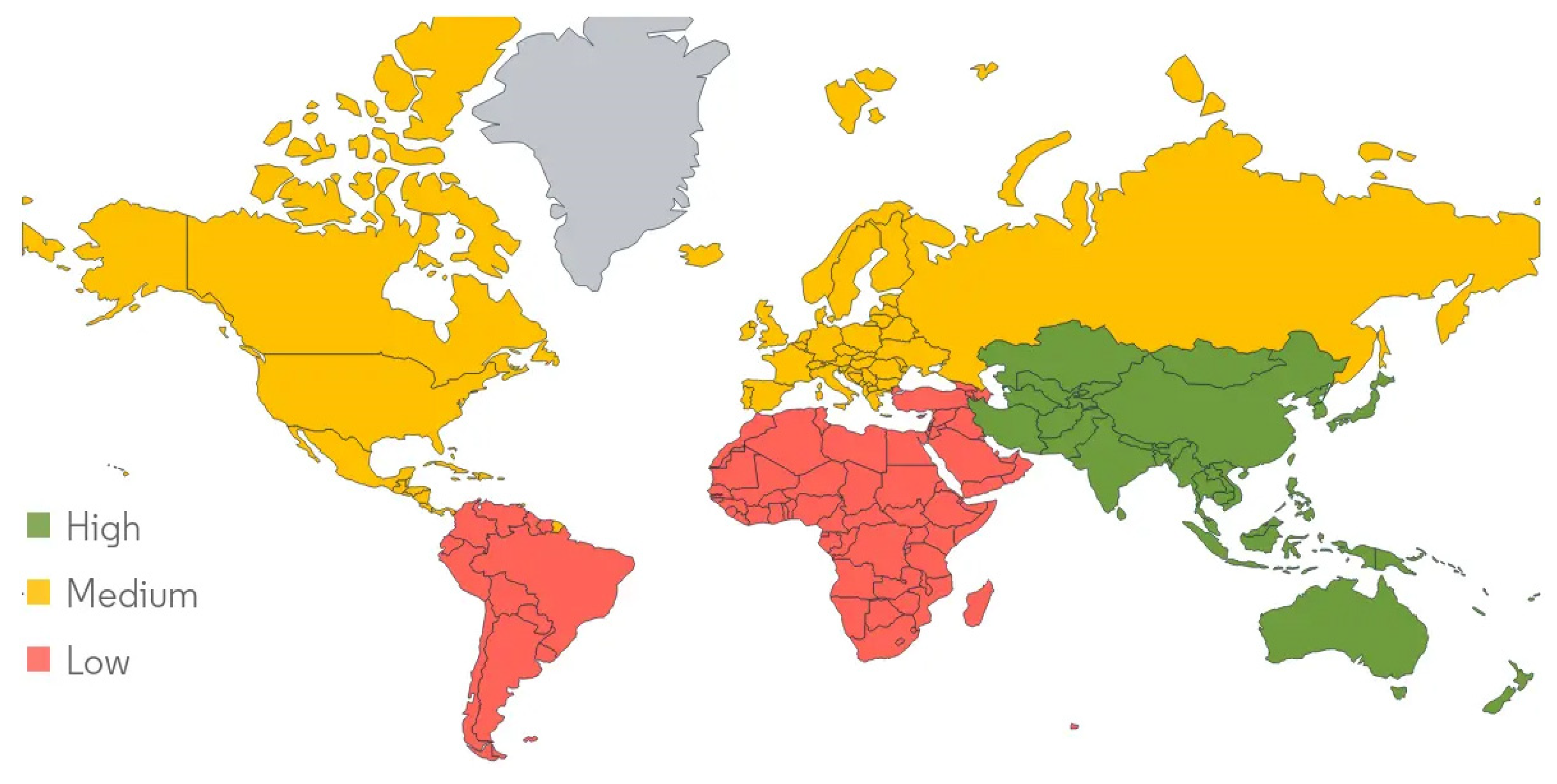
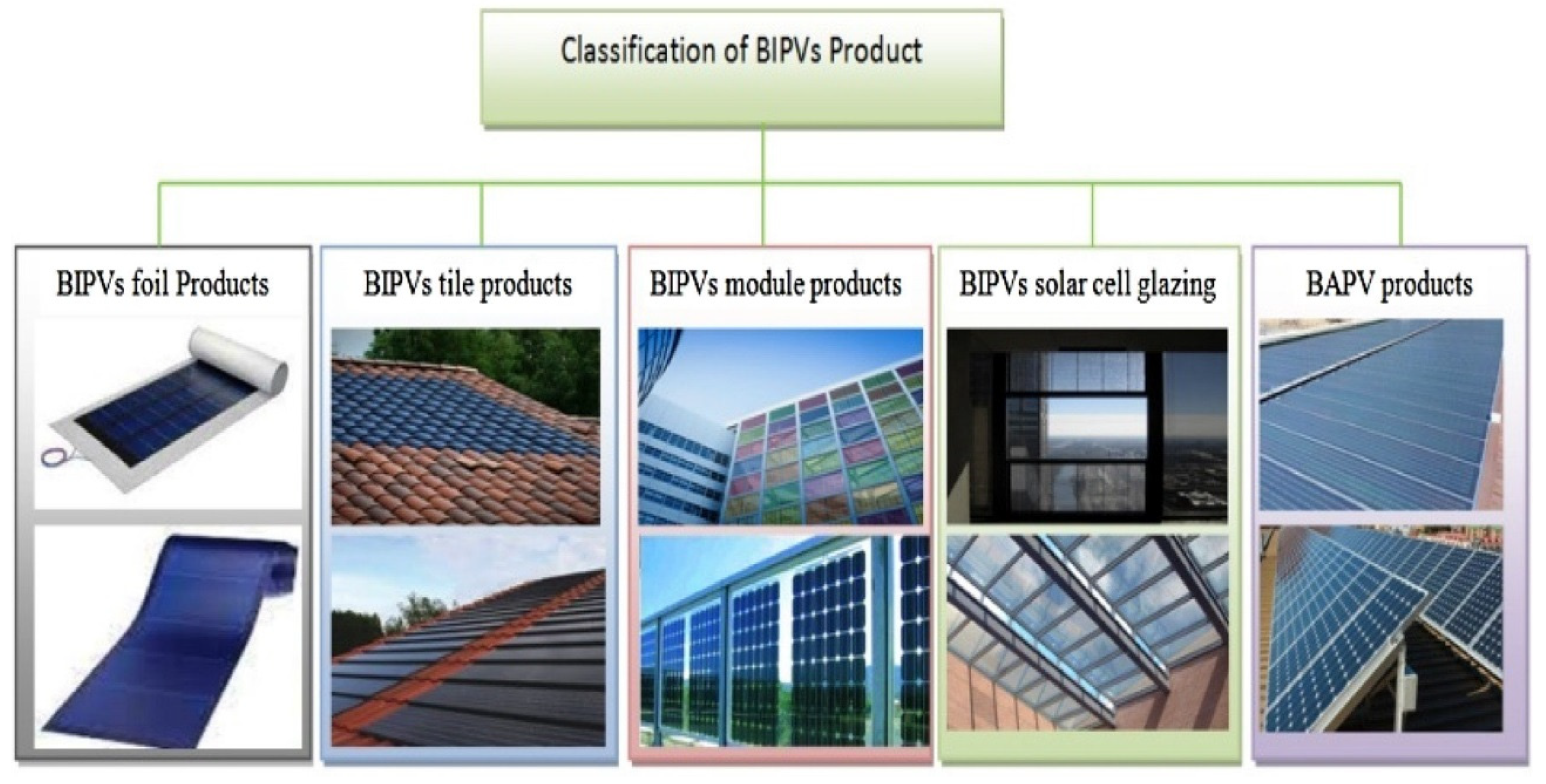

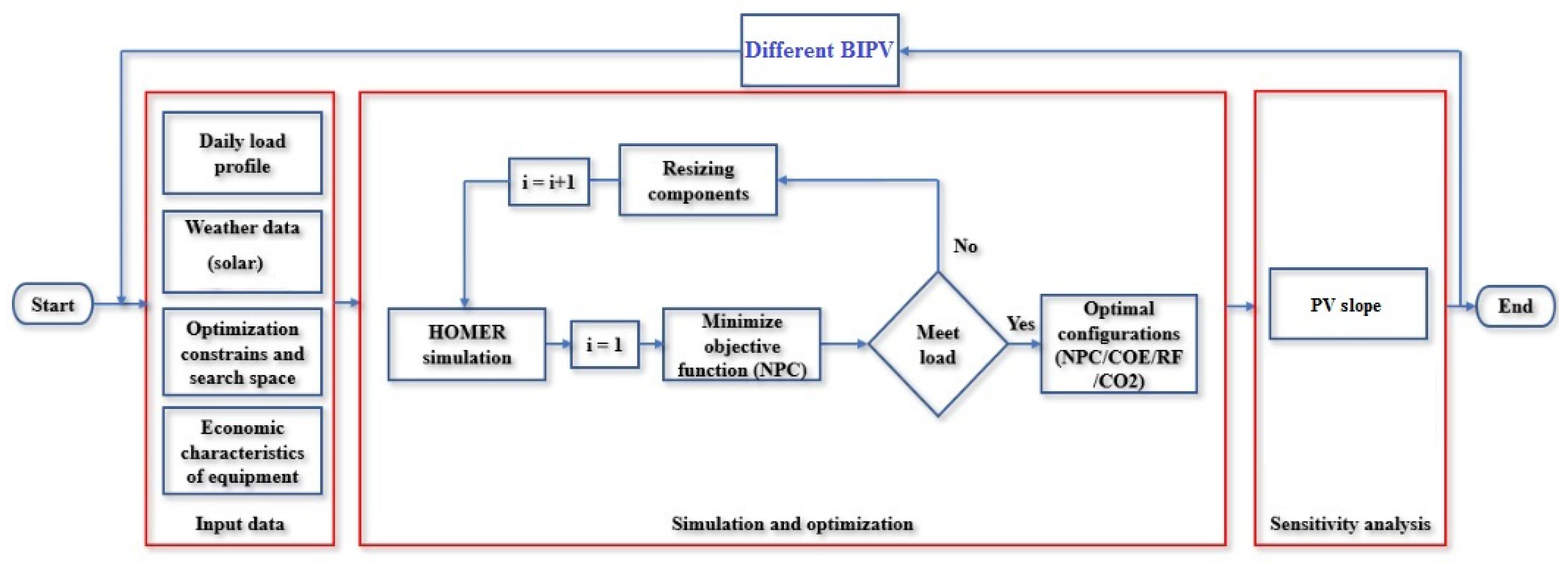
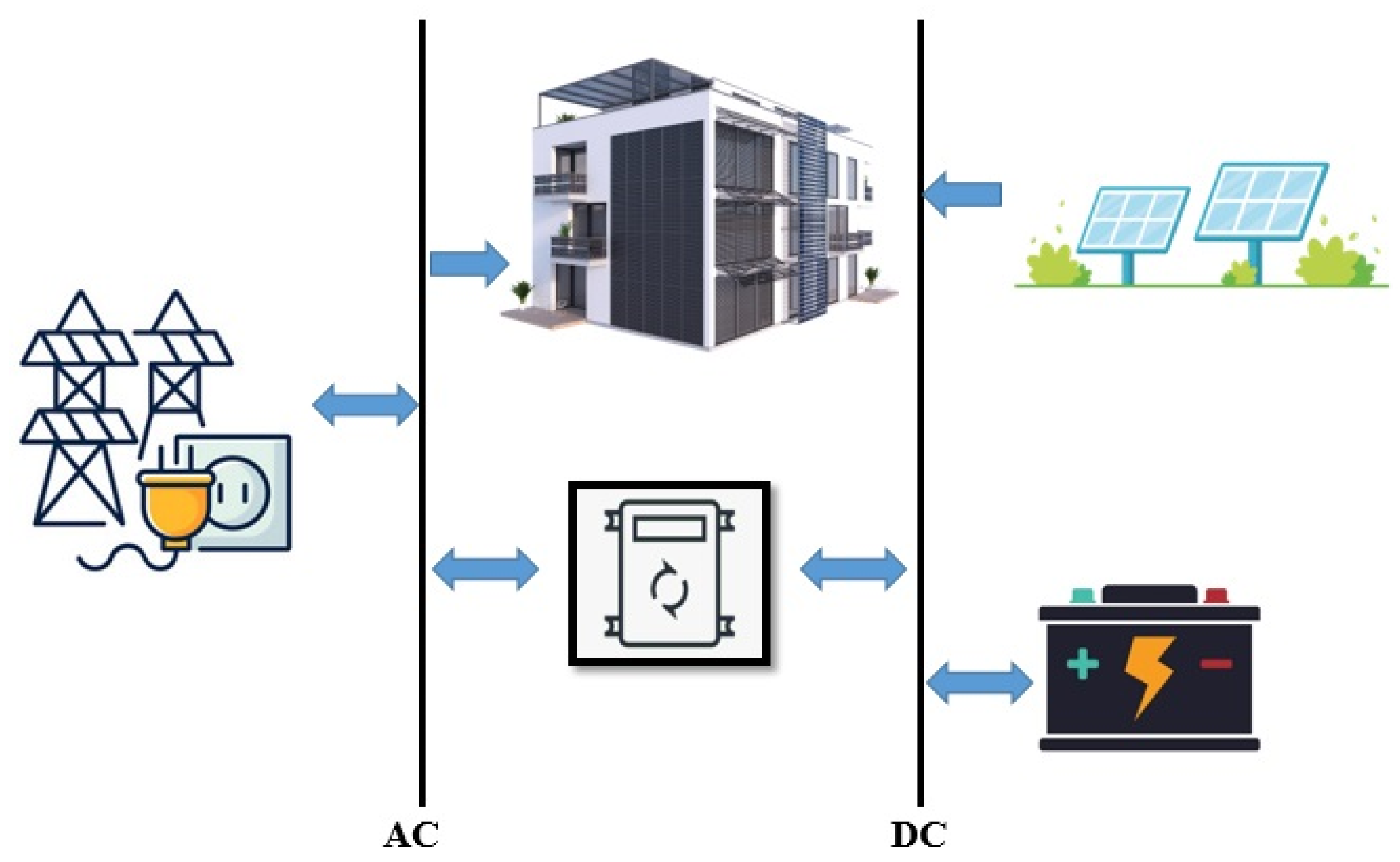
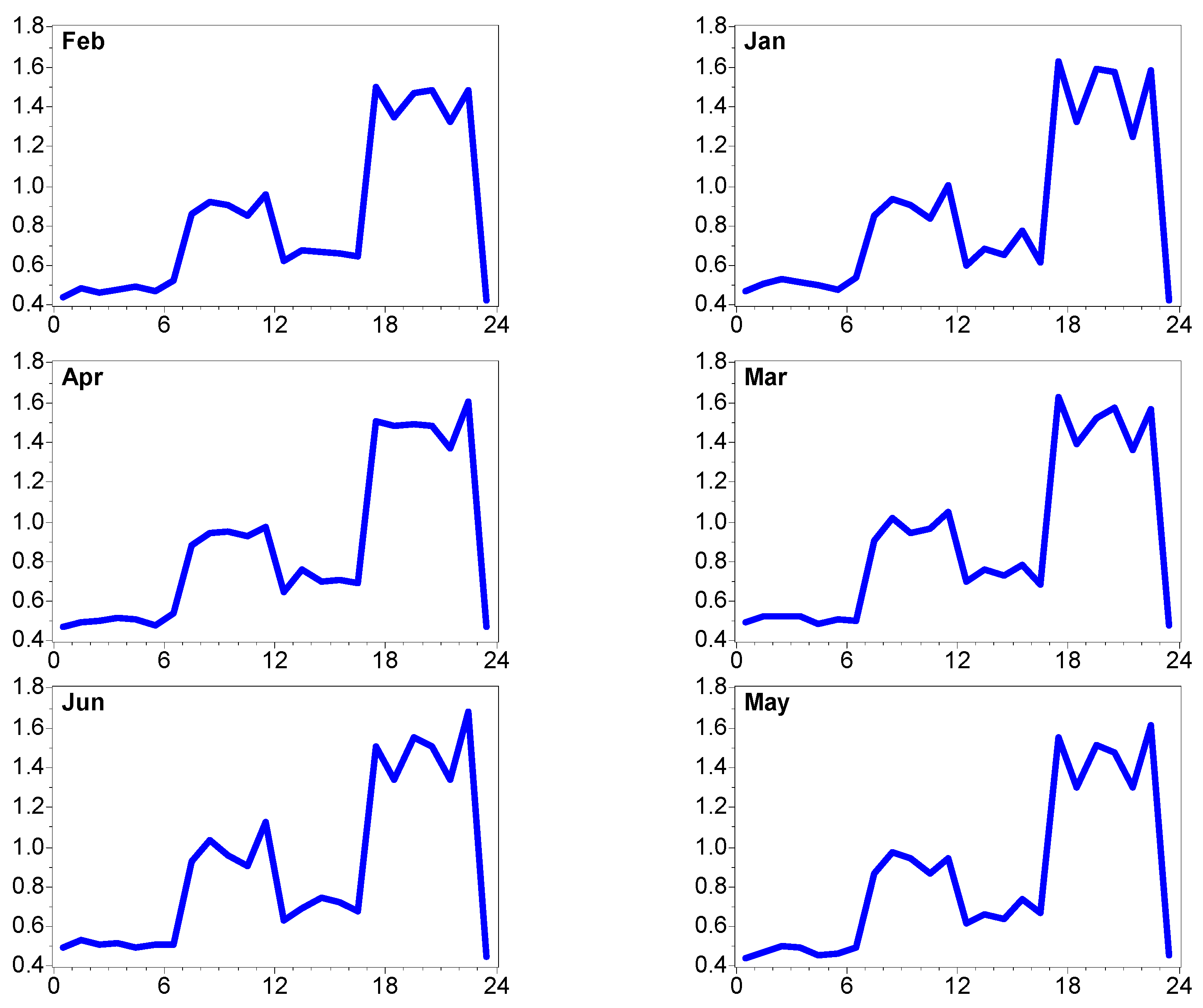
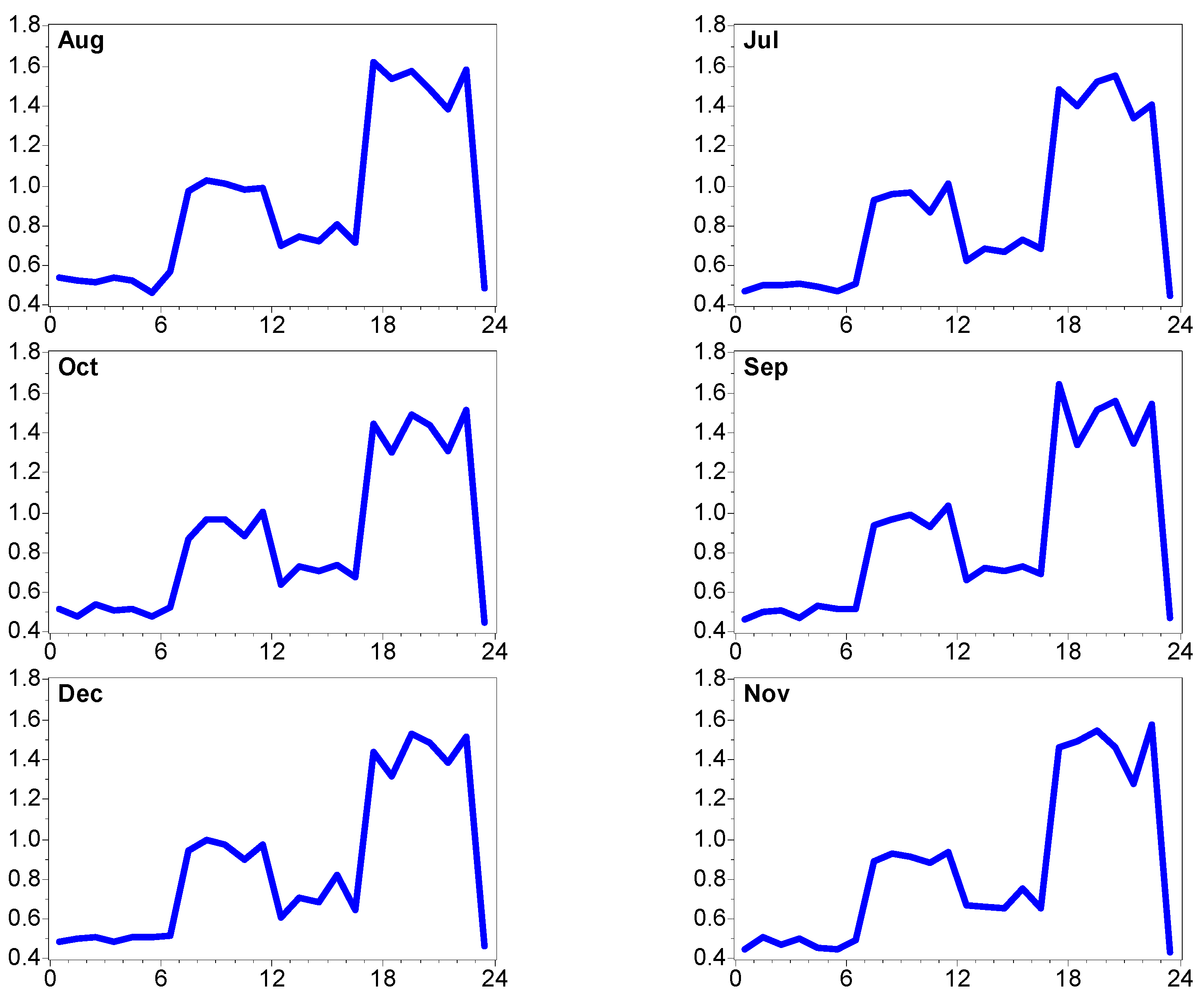


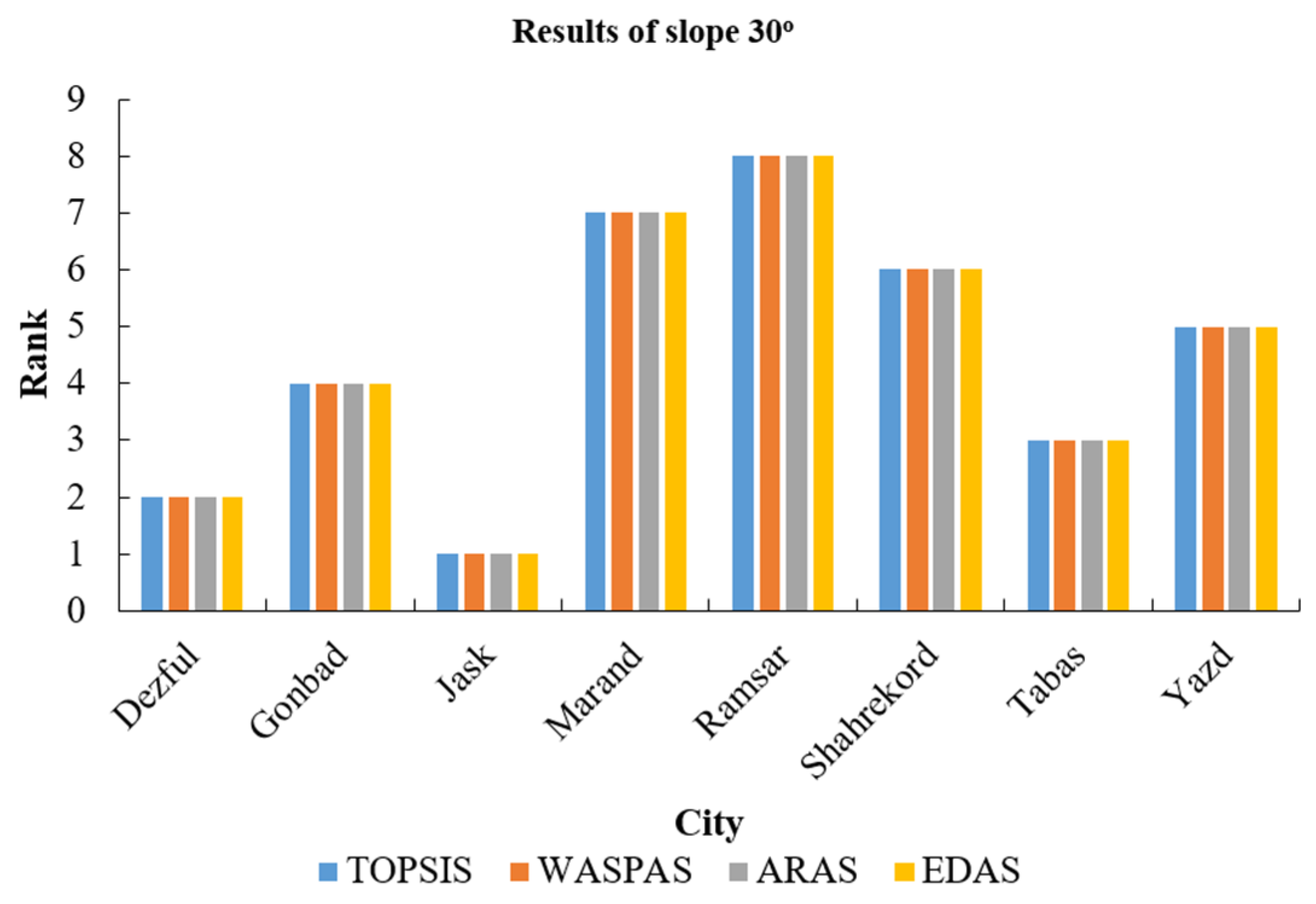


| Source | Purpose of Study | Analysis and Method Used | Results |
|---|---|---|---|
| [5] | The technical and economic feasibility of using a thin-film cadmium telluride (CdTe) BIPV system in the same building in six Brazilian cities | EnergyPlus and PVSyst | The results showed that the net annual energy consumption of the studied building could be supplied by BIPV systems installed on the roof and the façade. |
| [23] | Evaluated the technical and economic performance of Italy’s first BIPV project after being in operation for 13 years, predicting the system’s overall performance during its lifetime | Visual inspection And infrared thermography | It was found that the system’s performance did not deteriorate drastically over 13 years. The performance decay was measured at 0.37% per year, which is less than that in a typical multi-crystalline silicon system—around 0.5% per year. |
| [24] | A life cycle cost analysis (LCCA) for a façade-mounted 127.5 kWP BIPV system with an estimated 55.5 MWh/m2 power output that was set up in Drammen, Norway. | Mendeley database | The LCCA indicators, namely discounted payback period (DPP), internal rate of return (IRR), cumulative net present value (NPV), and levelized cost of energy (LCOE), were 22 years, 6%, 478,934 NOK, and 1.28 NOK/kWh |
| [25] | Evaluation of the economic aspect of BIPV systems as building envelopes with different orientations for implementation in all EU capitals, as well as capitals of Norway and Switzerland. | Economic analysis | As an envelope for the entire building, the BIPV system not only repays all investment costs but also can be a source of revenue for the residents. |
| [26] | The energy and economic performance of BIPV systems and also other influential factors, including the transmitted solar gain, weather conditions, building orientation, and the type of photovoltaic devices in three Iranian cities, namely Tehran, Bandar Abbas, and Tabriz. | DesignBuilder And EnergyPlus | Energy consumption highly depends on the building’s orientation, and the minimum consumption demand in Tehran and Tabriz is achieved on the south side of the BIPV, but on the north side in Bandar Abbas. The maximum energy demand in Tehran was achieved at 285°, but at 60° in Tabriz and 255° in Bandar Abbas. |
| [27] | BIM-PVSITES toolkit for a technical–economic evaluation of the BIPV system in a cluster of small residential buildings in Ludvika, Sweden | BIM platform (Revit) and PVSITES | Simulation results for the 615 m2 BIPV, comprising 776 BIPV modules, three solar string-optimizers, and a heat exchanger suggests that the system can produce 35.7 kWP at a maximum rate of 27,394 kWh/year. |
| [28] | Comparison of the performance of thin-film cadmium telluride (CdTe) BIPV systems installed on a flat roof and east, west, and north sides of the building in a tropical climate in Kuala Pahang, Malaysia | Photovoltaic Geographical Information System (PVGIS) | The results showed the performance ratios for the 7 kW system mounted on the flat roof, 2.3 kW system on the east and west sides, and 5.5 kW system on the north side were 76.26, 70, 70.53, and 66.42%, respectively. |
| City | Monthly Average Solar Radiation (kWh/m2—Day) | Longitude (XX° XX′ East) | Latitude (XX° XX′ North) | Annual Average Clearness Index | Köppen Climate Classification [29] |
|---|---|---|---|---|---|
| Dezful | 5.51 | 48 50 | 32 40 | 0.646 | BSh |
| Gonbad | 5.07 | 58 59 | 34 40 | 0.607 | BSk |
| Jask | 6.18 | 57 50 | 25 59 | 0.683 | BWh |
| Marand | 4.71 | 45 59 | 38 40 | 0.591 | BSk |
| Ramsar | 4.34 | 50 59 | 36 59 | 0.534 | Cfa |
| Shahrekord | 5.06 | 50 59 | 32 30 | 0.593 | BSk |
| Tabas | 5.17 | 56 90 | 33 60 | 0.609 | BWh |
| Yazd | 5.15 | 54 40 | 31 59 | 0.601 | BWh |
| Equipment | Cost | Size (kW) | Other Information | ||
|---|---|---|---|---|---|
| Capital | Replacement | Operating & Maintenance | |||
| ($) | ($) | ($/Year) | |||
| PV [65] | 1000 | 1000 | 5 | 0, 50 | Lifetime: 25 years |
| Ground reflectance: 20% | |||||
| Battery T-105 [66] | 174 | 174 | 5 | 0–5 | Nominal Voltage: 6 |
| Nominal capacity: 225Ah | |||||
| Converter [67] | 200 | 200 | 10 | 0–20 | Lifetime: 10 years |
| Efficiency: 90% | |||||
| City | Total NPC ($) | LCOE ($/kWh) | Renewable Fraction (%) | Payback Time (Year) | PV Production (kWh/Year) | Excess Electricity (kWh/Year) | PV Capacity Factor (%) | Inverter Losses (kWh/Year) | Net Sold to Grid (kWh/Year) | CO2 Emission Avoided (kg/Year) |
|---|---|---|---|---|---|---|---|---|---|---|
| Dezful | 16,543 | 0.096 | 87.1 | 13.6 | 32,147 | 1703 | 18.3 | 3045 | 19,772 | 12,496 |
| Gonbad | 17,660 | 0.111 | 85.4 | 15.5 | 29,566 | 2025 | 16.9 | 2754 | 17,159 | 10,845 |
| Jask | 15,767 | 0.082 | 88.2 | 12.5 | 36,050 | 1383 | 20.6 | 3144 | 23,572 | 14,897 |
| Marand | 17,768 | 0.119 | 85.1 | 15.7 | 27,476 | 1606 | 15.7 | 2587 | 15,655 | 9894 |
| Ramsar | 18,627 | 0.136 | 83.3 | 17.8 | 25,319 | 2182 | 14.5 | 2314 | 13,195 | 8339 |
| Shahrekord | 17,461 | 0.108 | 86 | 15 | 29,524 | 1395 | 16.9 | 2813 | 17,688 | 11,179 |
| Tabas | 17,401 | 0.106 | 86.1 | 14.9 | 30,162 | 1294 | 17.2 | 2887 | 18,353 | 11,599 |
| Yazd | 17,413 | 0.106 | 86.1 | 14.9 | 30,049 | 1370 | 17.2 | 2868 | 18,182 | 11,491 |
| City | Total NPC ($) | LCOE ($/kWh) | Renewable Fraction (%) | Payback Time (Year) | PV Production (kWh/Year) | Excess Electricity (kWh/Year) | PV Capacity Factor (%) | Inverter Losses (kWh/Year) | Net Sold to Grid (kWh/Year) | CO2 Emission Avoided (kg/Year) |
|---|---|---|---|---|---|---|---|---|---|---|
| Dezful | 15,696 | 0.081 | 88.4 | 12.4 | 35,757 | 1114 | 20.4 | 3465 | 23,550 | 14,884 |
| Gonbad | 16,858 | 0.094 | 86.9 | 13.9 | 33,445 | 1706 | 19.1 | 3174 | 20,936 | 13,232 |
| Jask | 15,108 | 0.073 | 88.8 | 11.7 | 39,014 | 1496 | 22.3 | 3752 | 26,138 | 16,519 |
| Marand | 16,790 | 0.098 | 86.9 | 13.8 | 31,808 | 1466 | 18.2 | 3034 | 19,680 | 12,438 |
| Ramsar | 18,024 | 0.117 | 85 | 16 | 28,449 | 1827 | 16.2 | 2662 | 16,331 | 10,321 |
| Shahrekord | 16,892 | 0.097 | 86.9 | 14 | 32,218 | 1533 | 18.4 | 3069 | 19,987 | 12,632 |
| Tabas | 16,617 | 0.092 | 87.2 | 13.6 | 33,802 | 1732 | 19.3 | 3207 | 21,234 | 13,420 |
| Yazd | 16,776 | 0.094 | 87 | 13.8 | 33,064 | 1626 | 18.9 | 3144 | 20,665 | 13,061 |
| City | Total NPC ($) | LCOE ($/kWh) | Renewable Fraction (%) | Payback Time (Year) | PV Production (kWh/Year) | Excess Electricity (kWh/Year) | PV Capacity Factor (%) | Inverter Losses (kWh/Year) | Net Sold to Grid (kWh/Year) | CO2 Emission Avoided (kg/Year) |
|---|---|---|---|---|---|---|---|---|---|---|
| Dezful | 16,866 | 0.1 | 86.5 | 14.1 | 31,984 | 2260 | 18.3 | 2973 | 19,123 | 12,085 |
| Gonbad | 17,731 | 0.108 | 85.4 | 15.5 | 30,629 | 2208 | 17.5 | 2842 | 17,950 | 11,345 |
| Jask | 16,688 | 0.092 | 87 | 13.7 | 33,788 | 1670 | 19.3 | 3212 | 21,278 | 13,448 |
| Marand | 17,472 | 0.11 | 85.6 | 15 | 29,789 | 2116 | 17 | 2768 | 17,278 | 10,919 |
| Ramsar | 18,731 | 0.133 | 83.3 | 17.8 | 26,068 | 2222 | 14.9 | 2385 | 13,833 | 8743 |
| Shahrekord | 17,957 | 0.119 | 84.6 | 16.1 | 28,515 | 2481 | 16.3 | 2604 | 15,801 | 9987 |
| Tabas | 17,605 | 0.108 | 85.6 | 15.2 | 30,599 | 2146 | 17.5 | 2846 | 17,980 | 11,363 |
| Yazd | 17,852 | 0.112 | 85.2 | 15.7 | 29,440 | 1855 | 16.8 | 2759 | 17,198 | 10,869 |
| City | Total NPC ($) | LCOE ($/kWh) | Renewable Fraction (%) | Payback Time (Year) | PV Production (kwh/Year) | Excess Electricity (kWh/Year) | PV Capacity Factor (%) | Inverter Losses (kWh/Year) | Net Sold to Grid (kWh/Year) | CO2 Emission Avoided (kg/Year) |
|---|---|---|---|---|---|---|---|---|---|---|
| Dezful | 19,470 | 0.161 | 80.8 | 22 | 22,228 | 2362 | 12.7 | 1986 | 10,251 | 6479 |
| Gonbad | 19,858 | 0.165 | 80.1 | 23.5 | 22,053 | 2440 | 12.6 | 1961 | 10,023 | 6335 |
| Jask | 19,603 | 0.160 | 80.8 | 22.5 | 22,420 | 2269 | 12.8 | 2015 | 10,508 | 6641 |
| Marand | 19,503 | 0.163 | 80.5 | 22.2 | 22,092 | 2538 | 12.6 | 1955 | 9970 | 6301 |
| Ramsar | 20,389 | 0.193 | 77.4 | n/a | 19,110 | 2493 | 10.9 | 1662 | 7327 | 4631 |
| Shahrekord | 20,154 | 0.186 | 78.2 | 24.8 | 19,768 | 2508 | 11.3 | 1726 | 7905 | 4996 |
| Tabas | 19,829 | 0.166 | 80.1 | 23.4 | 21,763 | 2320 | 12.4 | 1944 | 9871 | 6238 |
| Yazd | 20,068 | 0.180 | 78.6 | 24.5 | 20,539 | 2768 | 11.7 | 1777 | 8366 | 5287 |
| Criteria | Average Relative Importance | Calculation of Kj | Calculation of the Initial Weight | Calculation of the Final Normalized Weight |
|---|---|---|---|---|
| Paybak time (year) | 1 | 1 | 1 | 0.159 |
| LCOE ($/kWh) | 0.06 | 1.06 | 0.943 | 0.150 |
| Total NPC ($) | 0.12 | 1.12 | 0.842 | 0.134 |
| Net sold to grid (kWh/year) | 0.11 | 1.11 | 0.759 | 0.121 |
| CO2 emission | 0.15 | 1.15 | 0.660 | 0.105 |
| PV capacity factor (%) | 0.19 | 1.19 | 0.555 | 0.088 |
| PV production (kWh/year) | 0.19 | 1.19 | 0.466 | 0.074 |
| Renewable fraction (%) | 0.11 | 1.11 | 0.420 | 0.067 |
| Excess electricity (kWh/year) | 0.19 | 1.19 | 0.353 | 0.056 |
| Inverter losses (kWh/year) | 0.25 | 1.25 | 0.282 | 0.045 |
| City | Total NPC ($) | LCOE ($/kWh) | Renewable Fraction (%) | Payback Time (Year) | PV Production (kWh/Year) | Excess Electricity (kWh/Year) | PV Capacity Factor (%) | Inverter Losses (kWh/Year) | Net Sold to Grid (kWh/Year) | CO2 Emission Avoided (kg/Year) |
|---|---|---|---|---|---|---|---|---|---|---|
| Dezful | 16,543 | 0.096 | 87.1 | 13.6 | 32,147 | 1703 | 18.3 | 3045 | 19,772 | 12,496 |
| Gonbad | 17,660 | 0.111 | 85.4 | 15.5 | 29,566 | 2025 | 16.9 | 2754 | 17,159 | 10,845 |
| Jask | 15,767 | 0.082 | 88.2 | 12.5 | 36,050 | 1383 | 20.6 | 3144 | 23,572 | 14,897 |
| Marand | 17,768 | 0.119 | 85.1 | 15.7 | 27,476 | 1606 | 15.7 | 2587 | 15,655 | 9894 |
| Ramsar | 18,627 | 0.136 | 83.3 | 17.8 | 25,319 | 2182 | 14.5 | 2314 | 13,195 | 8339 |
| Shahrekord | 17,461 | 0.108 | 86 | 15 | 29,524 | 1395 | 16.9 | 2813 | 17,688 | 11,179 |
| Tabas | 17,401 | 0.106 | 86.1 | 14.9 | 30,162 | 1294 | 17.2 | 2887 | 18,353 | 11,599 |
| Yazd | 17,413 | 0.106 | 86.1 | 14.9 | 30,049 | 1370 | 17.2 | 2868 | 18,182 | 11,491 |
| City | EDAS | ARAS | WASPAS | TOPSIS | ||||
|---|---|---|---|---|---|---|---|---|
| ASi | Rank | Ki | Rank | WPSi | Rank | Ci | Rank | |
| Dezful | 0.712 | 2 | 0.869 | 2 | 0.871 | 2 | 0.654 | 2 |
| Gonbad | 0.524 | 3 | 0.817 | 3 | 0.817 | 3 | 0.466 | 3 |
| Jask | 0.921 | 1 | 0.937 | 1 | 0.935 | 1 | 0.743 | 1 |
| Marand | 0.302 | 7 | 0.761 | 7 | 0.764 | 7 | 0.302 | 7 |
| Ramsar | 0.161 | 8 | 0.739 | 8 | 0.734 | 8 | 0.276 | 8 |
| Shahrekord | 0.422 | 6 | 0.790 | 6 | 0.793 | 6 | 0.433 | 6 |
| Tabas | 0.437 | 5 | 0.794 | 5 | 0.796 | 5 | 0.460 | 5 |
| Yazd | 0.451 | 4 | 0.797 | 4 | 0.800 | 4 | 0.462 | 4 |
| City | Total NPC ($) | LCOE ($/kWh) | Renewable Fraction (%) | Payback Time (Year) | PV Production (kWh/Year) | Excess Electricity (kWh/Year) | PV Capacity Factor (kW) | Inverter Losses (kWh/Year) | Net Sold to Grid (kWh/Year) | CO2 Emission Avoided (kg/Year) |
|---|---|---|---|---|---|---|---|---|---|---|
| Dezful | 15,696 | 0.081 | 88.4 | 12.4 | 35,757 | 1114 | 20.4 | 3465 | 23,550 | 14,884 |
| Gonbad | 16,858 | 0.094 | 86.9 | 13.9 | 33,445 | 1706 | 19.1 | 3174 | 20,936 | 13,232 |
| Jask | 15,108 | 0.073 | 88.8 | 11.7 | 39,014 | 1496 | 22.3 | 3752 | 26,138 | 16,519 |
| Marand | 16,790 | 0.098 | 86.9 | 13.8 | 31,808 | 1466 | 18.2 | 3034 | 19,680 | 12,438 |
| Ramsar | 18,024 | 0.117 | 85 | 16 | 28,449 | 1827 | 16.2 | 2662 | 16,331 | 10,321 |
| Shahrekord | 16,892 | 0.097 | 86.9 | 14 | 32,218 | 1533 | 18.4 | 3069 | 19,987 | 12,632 |
| Tabas | 16,617 | 0.092 | 87.2 | 13.6 | 33,802 | 1732 | 19.3 | 3207 | 21,234 | 13,420 |
| Yazd | 16,776 | 0.094 | 87 | 13.8 | 33,064 | 1626 | 18.9 | 3144 | 20,665 | 13,061 |
| City | EDAS | ARAS | WASPAS | TOPSIS | ||||
|---|---|---|---|---|---|---|---|---|
| ASi | Rank | Ki | Rank | WPSi | Rank | Ci | Rank | |
| Dezful | 0.702 | 2 | 0.901 | 2 | 0.900 | 2 | 0.708 | 2 |
| Gonbad | 0.492 | 4 | 0.844 | 4 | 0.846 | 4 | 0.503 | 4 |
| Jask | 0.966 | 1 | 0.977 | 1 | 0.975 | 1 | 0.864 | 1 |
| Marand | 0.386 | 7 | 0.817 | 7 | 0.819 | 7 | 0.411 | 7 |
| Ramsar | 0.056 | 8 | 0.742 | 8 | 0.742 | 8 | 0.196 | 8 |
| Shahrekord | 0.404 | 6 | 0.821 | 6 | 0.823 | 6 | 0.426 | 6 |
| Tabas | 0.539 | 3 | 0.856 | 3 | 0.858 | 3 | 0.545 | 3 |
| Yazd | 0.475 | 5 | 0.840 | 5 | 0.841 | 5 | 0.491 | 5 |
| City | Total NPC ($) | LCOE ($/kWh) | Renewable Fraction (%) | Payback Time (Year) | PV Production (kWh/Year) | Excess Electricity (kWh/Year) | PV Capacity Factor (kW) | Inverter Losses (kWh/Year) | Net Sold to Grid (kWh/Year) | CO2 Emission Avoided (kg/Year) |
|---|---|---|---|---|---|---|---|---|---|---|
| Dezful | 16,866 | 0.1 | 86.5 | 14.1 | 31,984 | 2260 | 18.3 | 2973 | 19,123 | 12,085 |
| Gonbad | 17,731 | 0.108 | 85.4 | 15.5 | 30,629 | 2208 | 17.5 | 2842 | 17,950 | 11,345 |
| Jask | 16,688 | 0.092 | 87 | 13.7 | 33,788 | 1670 | 19.3 | 3212 | 21,278 | 13,448 |
| Marand | 17,472 | 0.11 | 85.6 | 15 | 29,789 | 2116 | 17 | 2768 | 17,278 | 10,919 |
| Ramsar | 18,731 | 0.133 | 83.3 | 17.8 | 26,068 | 2222 | 14.9 | 2385 | 13,833 | 8743 |
| Shahrekord | 17,957 | 0.119 | 84.6 | 16.1 | 28,515 | 2481 | 16.3 | 2604 | 15,801 | 9987 |
| Tabas | 17,605 | 0.108 | 85.6 | 15.2 | 30,599 | 2146 | 17.5 | 2846 | 17,980 | 11,363 |
| Yazd | 17,852 | 0.112 | 85.2 | 15.7 | 29,440 | 1855 | 16.8 | 2759 | 17,198 | 10,869 |
| City | EDAS | ARAS | WASPAS | TOPSIS | ||||
|---|---|---|---|---|---|---|---|---|
| ASi | Rank | Ki | Rank | WPSi | Rank | Ci | Rank | |
| Dezful | 0.777 | 2 | 0.935 | 2 | 0.936 | 2 | 0.758 | 2 |
| Gonbad | 0.546 | 4 | 0.884 | 4 | 0.886 | 4 | 0.574 | 4 |
| Jask | 0.932 | 1 | 0.969 | 1 | 0.967 | 1 | 0.803 | 1 |
| Marand | 0.506 | 5 | 0.876 | 5 | 0.877 | 5 | 0.534 | 5 |
| Ramsar | 0.040 | 8 | 0.774 | 8 | 0.774 | 8 | 0.160 | 8 |
| Shahrekord | 0.356 | 7 | 0.841 | 7 | 0.842 | 7 | 0.367 | 7 |
| Tabas | 0.557 | 3 | 0.887 | 3 | 0.888 | 3 | 0.585 | 3 |
| Yazd | 0.418 | 6 | 0.856 | 6 | 0.857 | 6 | 0.469 | 6 |
| City | Total NPC ($) | LCOE ($/kWh) | Renewable Fraction (%) | Payback Time (Year) | PV Production (kWh/Year) | Excess Electricity (kWh/Year) | PV Capacity Factor (kW) | Inverter Losses (kWh/Year) | Net Sold to Grid (kWh/Year) | CO2 Emission Avoided (kg/Year) |
|---|---|---|---|---|---|---|---|---|---|---|
| Dezful | 19,470 | 0.161 | 80.8 | 22 | 22,228 | 2362 | 12.7 | 1986 | 10,251 | 6479 |
| Gonbad | 19,858 | 0.165 | 80.1 | 23.5 | 22,053 | 2440 | 12.6 | 1961 | 10,023 | 6335 |
| Jask | 19,603 | 0.160 | 80.8 | 22.5 | 22,420 | 2269 | 12.8 | 2015 | 10,508 | 6641 |
| Marand | 19,503 | 0.163 | 80.5 | 22.2 | 22,092 | 2538 | 12.6 | 1955 | 9970 | 6301 |
| Ramsar | 20,389 | 0.193 | 77.4 | n/a | 19,110 | 2493 | 10.9 | 1662 | 7327 | 4631 |
| Shahrekord | 20,154 | 0.186 | 78.2 | 24.8 | 19,768 | 2508 | 11.3 | 1726 | 7905 | 4996 |
| Tabas | 19,829 | 0.166 | 80.1 | 23.4 | 21,763 | 2320 | 12.4 | 1944 | 9871 | 6238 |
| Yazd | 20,068 | 0.180 | 78.6 | 24.5 | 20,539 | 2768 | 11.7 | 1777 | 8366 | 5287 |
| City | EDAS | ARAS | WASPAS | TOPSIS | ||||
|---|---|---|---|---|---|---|---|---|
| ASi | Rank | Ki | Rank | WPSi | Rank | Ci | Rank | |
| Dezful | 0.930 | 2 | 0.977 | 2 | 0.978 | 2 | 0.809 | 1 |
| Gonbad | 0.686 | 4 | 0.956 | 4 | 0.957 | 4 | 0.7171 | 4 |
| Jask | 0.958 | 1 | 0.978 | 1 | 0.978 | 1 | 0.797 | 2 |
| Marand | 0.839 | 3 | 0.971 | 3 | 0.971 | 3 | 0.791 | 3 |
| Ramsar | -- | -- | -- | -- | -- | -- | -- | -- |
| Shahrekord | 0.062 | 7 | 0.873 | 7 | 0.872 | 7 | 0.136 | 7 |
| Tabas | 0.599 | 5 | 0.948 | 5 | 0.949 | 5 | 0.672 | 5 |
| Yazd | 0.266 | 6 | 0.899 | 6 | 0.898 | 6 | 0.268 | 6 |
| City | EDAS | ARAS | WASPAS | TOPSIS | Average Ranking | Rank |
|---|---|---|---|---|---|---|
| Dezful | 2 | 2 | 2 | 1 | 1.75 | 2 |
| Gonbad | 4 | 4 | 4 | 4 | 4 | 4 |
| Jask | 1 | 1 | 1 | 2 | 1.25 | 1 |
| Marand | 3 | 3 | 3 | 3 | 3 | 3 |
| Ramsar | -- | -- | -- | -- | -- | -- |
| Shahrekord | 7 | 7 | 7 | 7 | 7 | 7 |
| Tabas | 5 | 5 | 5 | 5 | 5 | 5 |
| Yazd | 6 | 6 | 6 | 6 | 6 | 6 |
Disclaimer/Publisher’s Note: The statements, opinions and data contained in all publications are solely those of the individual author(s) and contributor(s) and not of MDPI and/or the editor(s). MDPI and/or the editor(s) disclaim responsibility for any injury to people or property resulting from any ideas, methods, instructions or products referred to in the content. |
© 2023 by the authors. Licensee MDPI, Basel, Switzerland. This article is an open access article distributed under the terms and conditions of the Creative Commons Attribution (CC BY) license (https://creativecommons.org/licenses/by/4.0/).
Share and Cite
Jahangiri, M.; Yousefi, Y.; Pishkar, I.; Hosseini Dehshiri, S.J.; Hosseini Dehshiri, S.S.; Fatemi Vanani, S.M. Techno–Econo–Enviro Energy Analysis, Ranking and Optimization of Various Building-Integrated Photovoltaic (BIPV) Types in Different Climatic Regions of Iran. Energies 2023, 16, 546. https://doi.org/10.3390/en16010546
Jahangiri M, Yousefi Y, Pishkar I, Hosseini Dehshiri SJ, Hosseini Dehshiri SS, Fatemi Vanani SM. Techno–Econo–Enviro Energy Analysis, Ranking and Optimization of Various Building-Integrated Photovoltaic (BIPV) Types in Different Climatic Regions of Iran. Energies. 2023; 16(1):546. https://doi.org/10.3390/en16010546
Chicago/Turabian StyleJahangiri, Mehdi, Yasaman Yousefi, Iman Pishkar, Seyyed Jalaladdin Hosseini Dehshiri, Seyyed Shahabaddin Hosseini Dehshiri, and Seyyed Mohammad Fatemi Vanani. 2023. "Techno–Econo–Enviro Energy Analysis, Ranking and Optimization of Various Building-Integrated Photovoltaic (BIPV) Types in Different Climatic Regions of Iran" Energies 16, no. 1: 546. https://doi.org/10.3390/en16010546
APA StyleJahangiri, M., Yousefi, Y., Pishkar, I., Hosseini Dehshiri, S. J., Hosseini Dehshiri, S. S., & Fatemi Vanani, S. M. (2023). Techno–Econo–Enviro Energy Analysis, Ranking and Optimization of Various Building-Integrated Photovoltaic (BIPV) Types in Different Climatic Regions of Iran. Energies, 16(1), 546. https://doi.org/10.3390/en16010546








